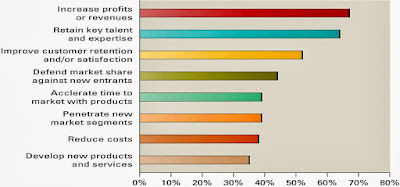- The core competency of an organization is its key strength, a business function that it does better than any of its competitors.
- A core competency strategy is one in which an organization chooses to focus specifically on what it does best ( its core competency ) and forms partnerships and alliances with other specialist organizations to handle nonstrategic business processes.
- An information partnership occurs when two or more organizations cooperate by integrating their IT systems, thereby providing customers with the best of what each can offer.
- Is an IT-based set of tools that supports the work of teams by facilitating the sharing and flow of information.
- Collaboration systems meet unique business challenges that :
- include complex interactions between people who may be in different locations and desire to work across function and discipline areas.
- require flexibility in work process and the ability to involve others quickly and easily.
- call for creating and sharing information rapidly and effortlessly within a team.
- Collaboration systems fall into one of two categories :
- unstructured collaboration.
- structured collaboration.
- Knowledge management (KM) - involves capturing, classifying, evaluating, retrieving, and sharing information assets in away that provides context for effective decisions and actions.
- A knowledge management system (KMS) supports the capturing, organization, and dissemination of knowledge throughout an organization.
- Explicit knowledge consists of anything that can be documented, archived, and codified, often with the help of IT.
- Tacit knowledge is the knowledge contained people's heads.
- Shadowing and joint problem solving are two best practices for transferring or re-creating tacit knowledge inside an organization.

Content Management Systems :
=> Provides tools to manage the creation, storage, editing, and publication of information in a collaborative environment.
Working Wikis :
=> Are web-based tools that make it easy for users to add, remove, and change online content.
Workflow Management Systems :
Workflow - all the steps or business rules, from beginning to end, required for a business process.
Workflow management systems - facilitate the automation and management of business processes and control the movement of work through the business process.
Messaging-based workflow systems - send work assignments through an e-mail system.
Database-based workflow systems - store documents in a central location and automatically ask the team members to access the document when it is their turn to edit the document.
Groupware Systems :
=> Is software that supports team interaction and dynamics including calendaring, scheduling, and videoconferencing.
Groupware systems fall along two primary categories :
1. users of the groupware are working together at the same time or different times.
2. users are working together in the same place or in different places.
Videoconferencing :
=> Is a set of interactive telecommunication technologies that allow two or more locations to interact via two-way video and audio transmissions simultaneously.
Web Conferencing :
=> Blends audio, video, and document-sharing technologies to create virtual meeting rooms where people 'gather' at a password-protected website.
Instant Messaging :
=> Is a type of communications service that enables someone to create a kind of private chat room with another individual in order to communicate in real time over the Internet.
Most of the popular instant messaging programs provide a variety of features, such as :
1. web links.
2. images.
3. sounds.
4. files.
5. talk.
6. streaming content.
7. instant messages.







No comments:
Post a Comment